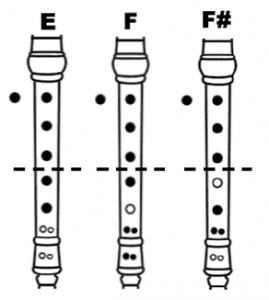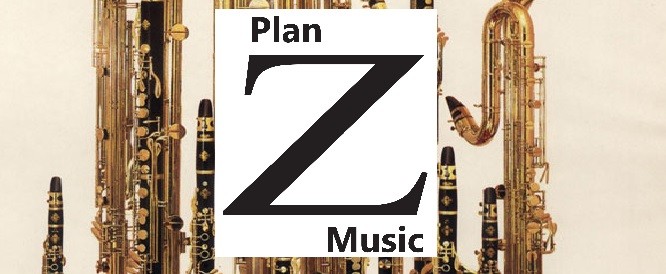For those of a scientific inclination, the following may be of interest: click here.
The problem
The recorder, a very simple wind instrument, is little more than a pipe with holes in it. The holes are opened and closed by finger action and enable the player to vary the effective length of the instrument, thereby varying the wavelength of the tone produced and playing a range of notes. The number of holes available is limited to the number of available fingers. Since the right thumb supports the instrument it cannot play any part in fingering notes. That leaves us with nine fingers, therefore nine notes. Those nine notes have been pitched to constitute part of a diatonic scale, which means there is no provision for chromatic notes: the sharps and flats. The same problem existed on the earliest forms of the flute, oboe and clarinet.
One solution
The full chromatic range can be obtained by cross-fingering. This entails closing one or more tone holes below the highest open one. For example, the recorder player moves from E to F by lifting the middle finger of the right hand. To play F# the index finger is lifted while the middle finger is replaced as shown below.
 As you can see, it’s a bit more complicated than that, but essentially the fingerings are the same as on the saxophone and in the second register of the clarinet. The problem associated with this is that it is well nigh impossible to achieve a perfect legato when swapping fingers in this way: there is always a bit of a “clonk” and a clearly discernible, unwanted note can creep in between the two desired tones. The other problem is that uniformity of tone colour is compromised as cross-fingered notes have a darker timbre. On larger instruments such as saxophones the technique simply cannot work.
As you can see, it’s a bit more complicated than that, but essentially the fingerings are the same as on the saxophone and in the second register of the clarinet. The problem associated with this is that it is well nigh impossible to achieve a perfect legato when swapping fingers in this way: there is always a bit of a “clonk” and a clearly discernible, unwanted note can creep in between the two desired tones. The other problem is that uniformity of tone colour is compromised as cross-fingered notes have a darker timbre. On larger instruments such as saxophones the technique simply cannot work.
A better solution
The other way round the problem is to drill more holes and get yourself some extra fingers, and that is effectively what keywork amounts to: the rise and fall of keys mimics the action of fingers and the soft skin or leather of the pads is similar to the cushioned fingertip. A variety of clever mechanisms bring all these extra tone holes within reach of the player’s nine fingers (on the modern, low C bass clarinet and the basset horn, even the right thumb has a busy time of it).
Players and instrument builders have developed a variety of key systems over the last 300 years or so and have succeeded in eliminating the need for cross-fingerings as employed on the recorder (the saxophone was born virtually fully grown around 1846: although its inventor, Adolph Sax was incontestably a genius, even this mechanism was built on principles developed for other instruments over a long period of time). However, much technique still calls for cross-fingering type action, in other words simultaneously lifting one or more fingers while lowering others, and legato can still be compromised. Whilst these are not cross-fingerings in the true sense, that is how I refer to them in my publications.
Much development of keywork has been aimed at eliminating the need for such cross-fingerings. On the boehm system clarinet there are alternative fingerings for throat F# and second register F# (and, therefore, low B), while the saxophone has alternative C and F# fingerings as well as a variety of fingerings for Bb. Many students are reluctant to take on board more than one fingering for any note, but it is important to employ appropriate fingerings to maximise smoothness. It really does matter: I have always regretted that the cross-fingering between top B and C on the German system clarinet can be a blemish on otherwise fine performances. The same action on the saxophone can be excruciating because of the size of the mechanisms involved and the relatively large distance through which keys move. It is particularly important to find mechanically simple solutions on the saxophone if one is to avoid sounding like an old fashioned typing pool. In my forthcoming series, Learn Your Scales and Arpeggios for Saxophone, I offer some fingering options which some may find unpalatable:
- I recommend using the side key fingering for C even when crossing between registers: for example, in both octaves of the scale of C major. Many players are reluctant to do this and, indeed, moving between side key C and second octave D also involves elements of cross-fingering, but I and those students who choose to follow my example can execute the relevant passages more quickly and smoothly than with the middle finger C.
- The side key fingering for Bb (or A#) should be used in all scales where those notes appear. The other Bb fingerings are for arpeggios. Using middle finger C with the bis-key fingering for Bb is as undesirable as cross-fingering between B and C in C major (it is not appropriate to combine the C side-key with with bis-key Bb as the C would be unacceptably flat).
- The long fingerings for Bb, using either the RH index finger or middle finger may be convenient when the note is adjacent to B§, but should not be used when also adjacent to a lower note as this would require a cross-fingering: in such instances, the side key fingering should be chosen.
The saxophone is a woefully underestimated instrument: when I was a student at a major British conservatory you could not take it as your principal study. To this day many teachers of other instruments imagine they only need to get a few simple fingerings sorted and they can then take on lucrative(!) extra work. I often have to undo the technical flaws and misconceptions in young saxophone players who have had the misfortune to take lessons from them (click here to see my previous post about junior schools).
